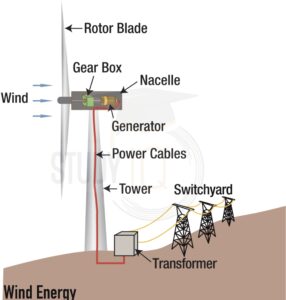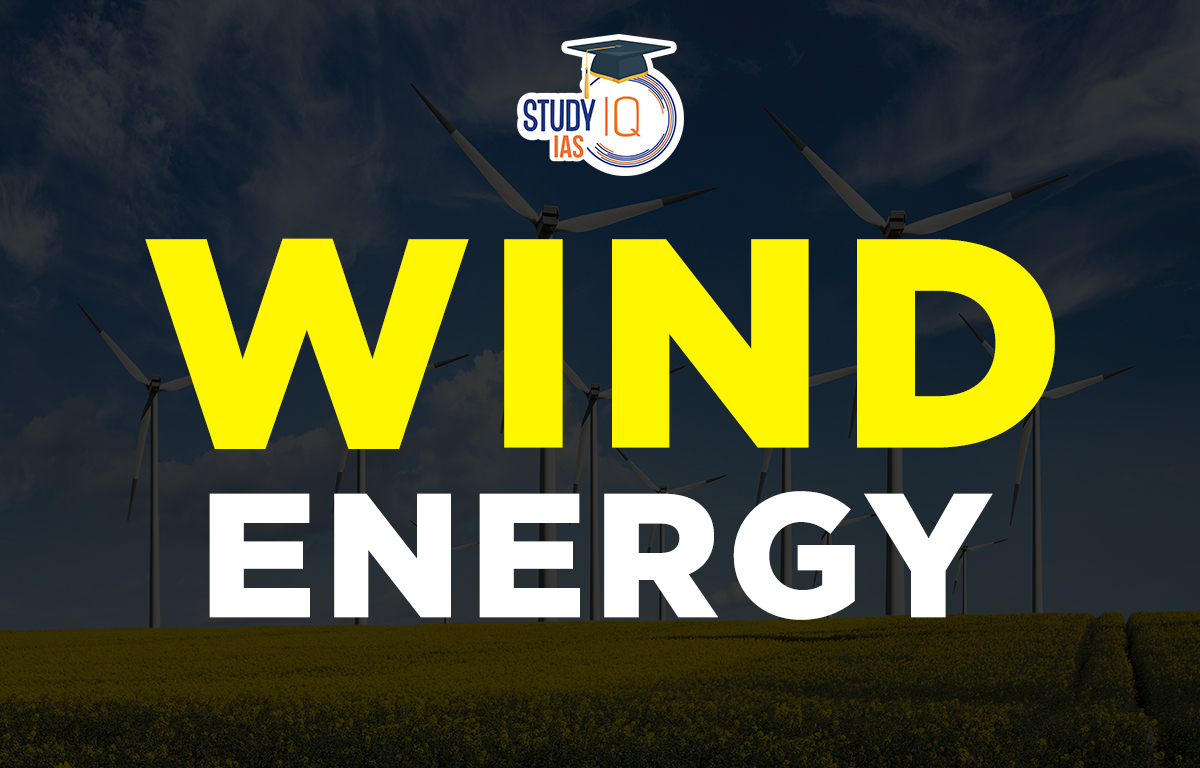Table of Contents
Wind Energy
Wind is available almost everywhere on Earth but its strength can be very different from place to place. The overall amount of wind energy is huge. It is also been found that electricity generated from wind can easily connect to local or national power grids. In the future, wind energy could make up about 20% of total electricity use. Right now, there are mainly two types of wind energy:
- Onshore wind farms are substantial on-land installations of wind turbines.
- Offshore wind farms are structures situated on the water.
Read More: Biomass Energy
Wind Energy in India
Asia accounted for around 50% of the wind power generation capacity. Wind Energy projects in India total 13.4 GW at this time, and
They are expected to boost market installations until 2024. India is likely to add 3.2 GW of wind power in 2022, 4.1 GW in 2023, and 4.6 GW in 2024, followed by 4 GW and 3.5 GW in the next two years. Since 2017, the speed of wind energy installations in India has slowed down. In 2021, only 1.45 GW of new wind projects were added, mainly due to the second wave of COVID-19 and supply chain problems. Even though India’s annual market shrank significantly, China continued to lead in new installations, with Europe and North America making up the rest of the 50%.
Read about: Hydropower Plants in India
Wind Energy Potential
As older wind power plants with lower capacity get replaced by newer, more powerful ones, it’s likely that overall wind energy production will increase a lot. However, offshore wind is still a new area with much to explore, and development in this field is just beginning worldwide.
Onshore wind power has been the main focus of India’s renewable energy efforts, but there is increasing interest, both in India and abroad, in using the country’s large offshore wind resources. To reach its goal of net zero emissions by 2070, India will need to fully use offshore wind energy. By 2027, India is expected to install 21.2 GW of offshore wind power. In a more ambitious scenario this could rise to 26.2 GW, while in a more cautious scenario, it could be 17 GW.

India faces challenges because cyclones hit its eastern coast. However, it could explore wind energy on the western side. With a coastline of 7,516.6 kilometers, India has many chances to use wind energy in its exclusive economic zones. The National Institute for Wind Energy reports that western states like Gujarat, Maharashtra, Karnataka, Tamil Nadu, and Andhra Pradesh have strong and steady winds. In 2019, Tamil Nadu generated 9,075 MW of wind energy.
Read about: Major Ports in India
Wind Energy Advantages
- Wind energy is cost-effective because its power is supplied at a fixed price over a long time, and the wind is free.
- The wind power industry creates jobs with wind turbine technician being one of the fastest-growing jobs.
- Wind energy boosts competitiveness and industry growth.
- Fossil fuel power plants (coal, natural gas) produce harmful pollutants that affect health and the economy, but wind energy does not.
- Wind turbines do not cause acid rain, smog, or greenhouse gases.
- Wind is abundant and free, created by the Earth’s rotation, the sun heating the atmosphere, and surface irregularities.
- As long as the sun shines and the wind blows, wind and solar energy can power the grid.
- Wind turbines can be installed on existing farms or ranches.
Read about: Nuclear Energy
Wind Energy Disadvantages
Gujarat and Tamil Nadu have the most wind energy potential and the cheapest land, which is why many wind farms are built there. However, this has caused some problems, slowing down projects and making wind power more expensive than solar power. The wind energy market in India has been quite unstable. Since 2017-2018, there has been a lot of progress in planning new projects, but delays in getting them done have raised doubts for developers.
Because of the COVID-19 pandemic and supply chain issues, the total amount owed by power distribution companies (DISCOMs) has gone up. By December 2021, unpaid bills to renewable energy generators reached ₹19,400 crores, which is a 73% increase from ₹11,200 crores in December 2020.
Read More: Minerals
Wind Energy Way Forward
- Governments need to tackle issues like connecting to the power grid and planning delays. They should simplify the licensing process, including land use and grid connections, to support and grow wind energy production.
- A mian focus should be on planning the workforce needed for big renewable energy projects, and investment in the grid must triple by 2030.
- There should also be more cooperation between the public and private sectors to deal with the new global challenges in the wind supply chain. To handle increasing competition for resources and important minerals, we need a stronger international set of rules.
Read about: Nuclear Power Plants in India
Wind Energy UPSC
India is making constant progress towards meeting its climate change obligations under the Paris Agreement (COP 21). India promised to take “a cleaner path than the one adopted by countries at a comparable level of economic development” during the climate summit. Wind energy is a form of renewable energy that harnesses the power of the wind to generate electricity. It is considered to be one of the most promising sources of clean energy, and its use is growing rapidly around the world.
Read More: Iron Ore


 Important Lakes of India, State wise and...
Important Lakes of India, State wise and...
 Buddhism History, Origin, Sect, Councils...
Buddhism History, Origin, Sect, Councils...
 Andaman and Nicobar Islands, History, Cl...
Andaman and Nicobar Islands, History, Cl...





















